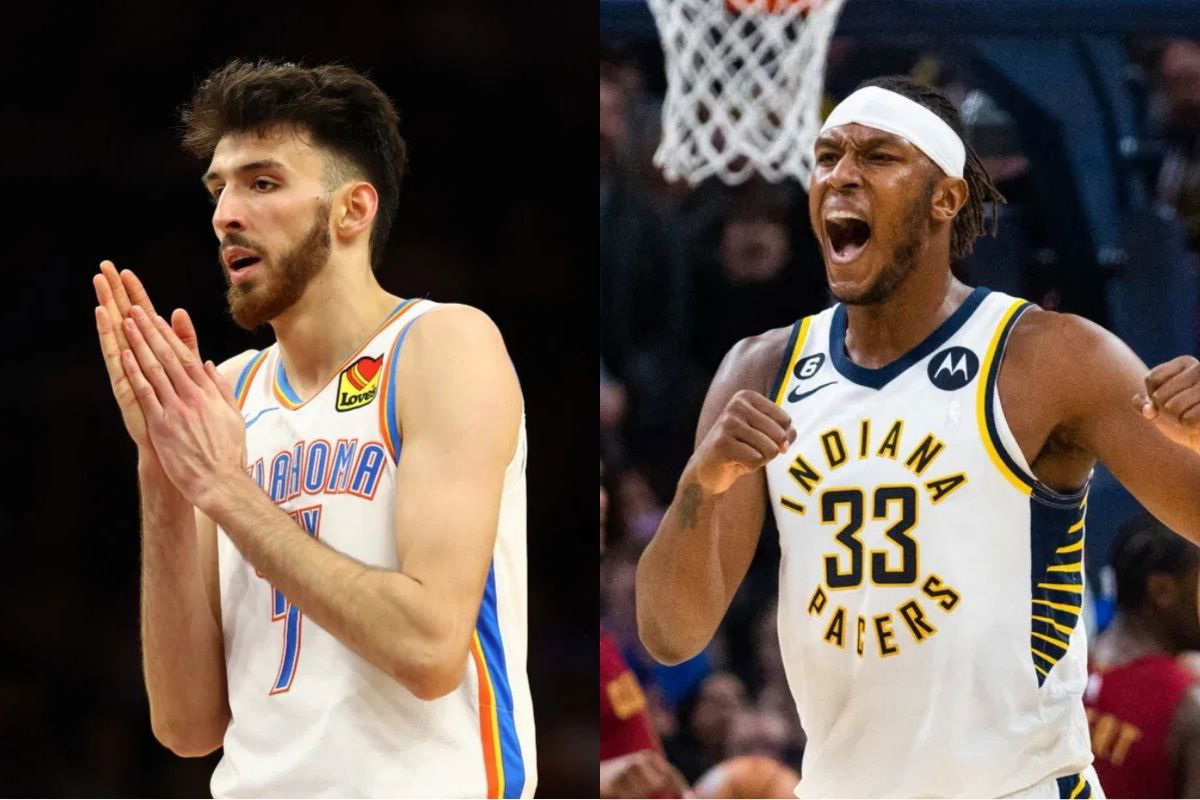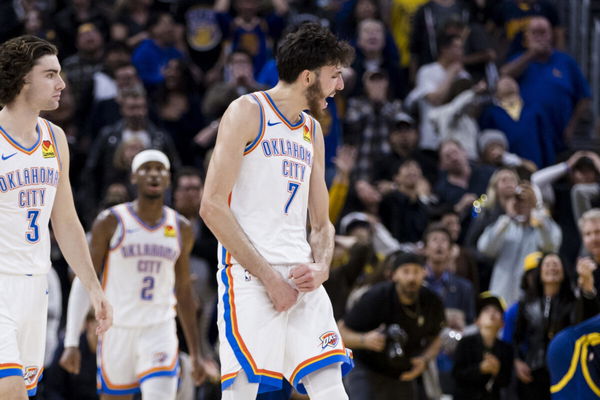

There’s too many parallels to draw from this NBA Finals. And the beauty of it all is that there are different storylines everywhere you look. A David vs Goliathesque Finals is looking set to finish in favor of the Goliath. And while the Pacers have their fair share of crucial veterans, the OKC run on an engine backed by youth.
Watch What’s Trending Now!
With a wealth of talent and unmatchable aura, OKC’s young guns are itching for their first-ever ring. Two players who fit this narrative to a tee are Myles Turner and Chet Holmgren. There’s a massive experience gap in the pair, but one man’s loss is another man’s gain. And that’s exactly what we intend to break down, here. Two world-class big men – but who’s the better one?
ADVERTISEMENT
Statistical Comparison: Points, Rebounds, Blocks, and Efficiency
Turner, drafted 11th overall by the ‘Cers in 2015, has touched the hardwood 642 times across 10 regular NBA seasons. In contrast, Holmgren, selected 2nd overall by the Thunder in 2022, has played 114 regular season games over just 2 seasons due to missing his entire rookie year with a Lisfranc injury. But are their box numbers as box office as this Finals series?
Putting the comparisons aside for a second, both are absolute statpadding demons. Chet’s healthy average of 16.5/7.9 (FG%: 53.2%, 3P%: 38.4%, TS%: 63.1%) is only aided by his ridiculous 2.4 BPG. But that’s due to his exceptional two-way ability. Turner’s more defensive minded for the Pacers. His averages aren’t as pretty, but numbers of 16.3/6.9 (FG%: 52.1%, 3P%: 35.2%, TS%: 62.0%) with 2.3 BPG isn’t something to be ashamed of.
View this post on Instagram
ADVERTISEMENT
The advanced metrics is where it gets interesting. While PER tells you “How good was he by the numbers?” BPM tells you “How much did he help his team win while on the court?” And the story in these metrics isn’t too different either. Chet Holmgren has a PER of 18.7 and BPM of +2.4, which are ridiculously above league averages. Turner on the other hand has a PER of 18.1 and a BPM of +1.9, indicating a similarly strong but slightly smaller above‑average impact—driven largely by his defense (rim protection) and floor spacing.
ADVERTISEMENT
Skill Set Breakdown: Offense, Defense, and Versatility
The numbers are down – now we speak about their true values and talent. Let’s start with the OKC star on offense. Holmgren ranks in the top 10 of all players in transition points per game, reflecting his ability to sprint the floor and finish in space, according to Basketball Reference. On top of that, he is shooting 37.9 percent of his threes on 3.6 attempts per game, ranking him 14th in 3‑P% among players with ≥3 attempts. Turner’s forte is more in the mid-range and pick-and-roll finishing. Turner averages 5.8 points per game as the roll man, shooting 63 percent on those attempts, and their Haliburton‑Turner duo generates 1.063 points per possession (5th‑best among 24 duos with ≥500 PnR plays).
Now’s when we come to Turner’s specialty. Indiana allows 109.7 points per 100 possessions with him on the floor—better than league average. And his 2.3 blocks put him into the top 20 rim protectors in the league. Dominion of the paint – that’s where Turner shines. Chet on the other hand is more specialized in switching and helping around the D. His on/off plus‑minus is +235 (team outscored opponents by 10.4 points per 100 possessions with him on the floor) highlights his disruptive presence. Turner is miles ahead in defense.

USA Today via Reuters
Nov 18, 2023; San Francisco, California, USA; Oklahoma City Thunder center Chet Holmgren (7) reacts after tying the score against the Golden State Warriors at the final buzzer to send the game in to overtime at Chase Center. Mandatory Credit: John Hefti-USA TODAY Sports
Versatility could be a bit of a problem for Pacers fans. Opponents score just 52.0 percent on isolation and pick‑and‑rolls when Holmgren switches onto guards (in the 8th percentile for big men). And as mentioned earlier, he can dominate on both C and PF positions. While Turner is an excellent drop‑coverage defender, he ranks in just the 20th percentile among centers in close‑out speed, making him less comfortable defending quick forwards on the perimeter.
ADVERTISEMENT
Team Role and Impact: How Each Player Shapes Their Team’s Success?
Chet Holmgren’s full game hinges on his two-way ability. He gives Mark Daigneault the absolute luxury of rotations, by deploying Chet at PF when Isaiah Hartenstein is on the floor. When he’s not, well that’s where his size and rim protection come into question. He is the key defensive anchor and offensive spacer in OKC’s core. Turner might not have the versatility, but he makes up for in defense what little he lacks in attack.
ADVERTISEMENT
Turner is that leader. He’s the longest tenured player on the Pacers roster. He posted 3.7 DWS in 2024‑25, which ranked 10th in the entire NBA. So while Holmgren’s both the Thunder’s defensive heartbeat and a 38 percent 3‑point shooter, Turner’s 10 seasons of leadership, delivering a top‑10 league‑wide mark in Defensive Win Shares, anchors the Pacers’ paint. You can’t really call one more valuable than the other.
Myler Turner and Chet Holmgren – an argument for the ages. This dissection just proves what everyone’s known since the beginning – no one’s inherently better. So just sit back, and enjoy the show. Which of these will come out victorious?
ADVERTISEMENT
ADVERTISEMENT
ADVERTISEMENT

